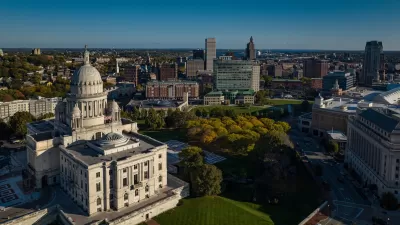Could Vienna's century of experience in creating housing that is both affordable and attractive offers lessons for how the U.S. can address its growing affordability crisis? In the Austrian capital, more regulation, not less, leads to cheaper rents.
While pundits in America lament the role of government regulation in driving up the cost of housing, "[a] unique system nearly a century in the making has created a situation today in which the city government of Vienna either owns or directly influences almost half the housing stock in the capital city," writes Ryan Holeywell. "As a result, residents enjoy high-quality apartments with inexpensive rent, along with renters’ rights that would be unheard of in the U.S."
"The Viennese have decided that housing is a human right so important that it shouldn’t be left up to the free market."
First established in Vienna in the 1920s, "[t]he idea that everyday citizens should have access to not just affordable apartments but also attractive ones -- and that it’s the city’s responsibility to provide them -- continues to this day. There’s a mindset that housing is a way to link residents to their communities and the larger city through design," notes Holeywell.
"Vienna’s government takes an approach to residential development that’s more rigorous and deliberative than many private-sector developers in America. That’s because in the U.S., 'cost is the No. 1 priority,' [architectural historian William] Menking says. In Vienna, it’s just one of four. At the same time, the competition among developers is so fierce -- the result of the city’s land monopoly -- that the result is a very affordable development. 'We were doing some comparisons of public housing in Los Angeles and public housing in Vienna,' Menking says, 'and Vienna was cheaper per square foot than L.A.'”
FULL STORY: Affordable and Luxurious Housing Come Hand in Hand in Vienna

Alabama: Trump Terminates Settlements for Black Communities Harmed By Raw Sewage
Trump deemed the landmark civil rights agreement “illegal DEI and environmental justice policy.”

Planetizen Federal Action Tracker
A weekly monitor of how Trump’s orders and actions are impacting planners and planning in America.

The 120 Year Old Tiny Home Villages That Sheltered San Francisco’s Earthquake Refugees
More than a century ago, San Francisco mobilized to house thousands of residents displaced by the 1906 earthquake. Could their strategy offer a model for the present?

In Both Crashes and Crime, Public Transportation is Far Safer than Driving
Contrary to popular assumptions, public transportation has far lower crash and crime rates than automobile travel. For safer communities, improve and encourage transit travel.

Report: Zoning Reforms Should Complement Nashville’s Ambitious Transit Plan
Without reform, restrictive zoning codes will limit the impact of the city’s planned transit expansion and could exclude some of the residents who depend on transit the most.

Judge Orders Release of Frozen IRA, IIJA Funding
The decision is a victory for environmental groups who charged that freezing funds for critical infrastructure and disaster response programs caused “real and irreparable harm” to communities.
Urban Design for Planners 1: Software Tools
This six-course series explores essential urban design concepts using open source software and equips planners with the tools they need to participate fully in the urban design process.
Planning for Universal Design
Learn the tools for implementing Universal Design in planning regulations.
Clanton & Associates, Inc.
Jessamine County Fiscal Court
Institute for Housing and Urban Development Studies (IHS)
City of Grandview
Harvard GSD Executive Education
Toledo-Lucas County Plan Commissions
Salt Lake City
NYU Wagner Graduate School of Public Service





























